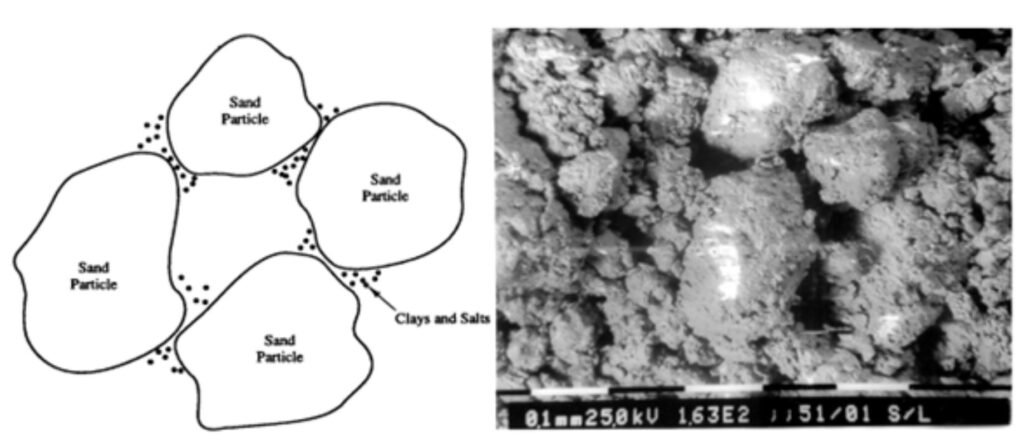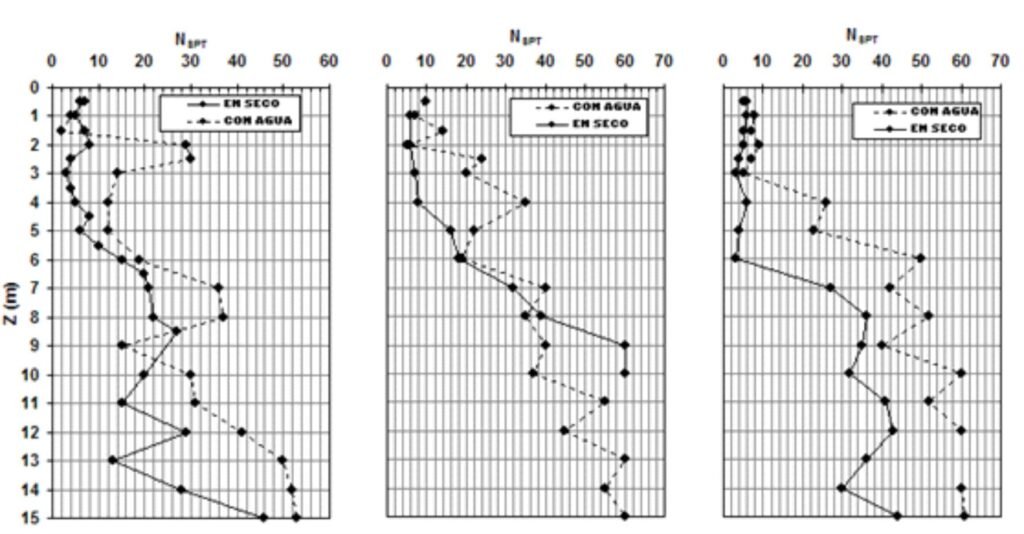

Exploration and sampling of potentially collapsible soils
Potentially collapsible soils are partially saturated, cemented soils that undergo a significant and fast reduction in volume when in contact with water. Because of this, and in order to minimize problems in projects, it is very important their detection and characterization during the geotechnical study. Do you want to know more about this topic? Continue reading this post...
Content
Definition of potentially collapsible soils
Potentially collapsible soils are partially saturated soils with an open structure, composed of a granular fraction bound together by cementitious materials or connectors, which form a macroporous mass of low density and high void ratio. Figure 1 shows a schematic of these soils, accompanied by a photograph taken under an electron microscope in the laboratory of the Simón Bolívar University, in Venezuela.

Figure 1 Structure of potentially collapsible soils (Source: Carrillo, 2005).
If you look closely at the photograph included in the figure above, you can see larger particles, which are the sand grains, and then a sort of bridges that join these sand particles (usually composed of salts, clay, carbonates and silicates), whose main common characteristic is that they are soluble in water.
The dark areas in the photograph correspond to voids. In relation to these voids, what stands out is that they are abundant, and that is the reason why we speak of a macroporous structure that, in addition, has a relatively low density.
As in any other particulate system, the stability of a potentially collapsible soil mass will depend on the stability of its weakest elements. In this case, those elements are the bridges between the sand particles, so the failure of the structure of a potentially collapsible soil would be associated with a failure of these junctions between the larger particles.
In potentially collapsible soils, failure is caused by the dissolution of the cementitious material (i.e., bridges of salts, clay, carbonates and silicates) due to wetting or saturation of the soil. In addition, it should be noted that this failure is characterized by the occurrence of significant and sudden settlements, associated to unanticipated reasons. Hence the name "collapsible" given to this type of material.
Geotechnical borehles in potentially collapsible soils
Given the sudden failure condition of these soils, it is important to detect them in early stages of a project. Accordingly, during the stage of analysis of existing information, it should be kept in mind that soils in which the collapse phenomenon is common are: a) recent soils (Holocene, less than 10,000 years ago); b) soils deposited in arid or semi-arid environments; c) loess; d) soils belonging to alluvial fans and/or mudflow; e) soils deposited during rapid flooding; f) residual soils resulting from rock weathering; g) fills with overturned material.
During the fieldwork, two things are of utmost importance in relation to exploration drillings:
- I. In these soils, the penetration resistance values of the SPT are generally less than 10 blows/foot, which is very useful for their identification in a given terrain.
- II. During the SPT it is necessary that the borehole be drilled dry, i.e. without the use of water injection or driven casing. en seco, es decir, sin utilizar inyección de agua ni tubería de forro hincada.
In relation to casing, collapsible soils can normally maintain stable walls in the borehole without the need for support, so the use of casing is usually not necessary.
And why is it important not to use water for drilling? Fundamentally, because, if water is used to advance the drilling, it may induce a premature collapse of the soil, which would increase the log in the SPT and make its identification more difficult.
From Figure 2, it is possible to compare the penetration resistance values of the SPT performed dry, with the values obtained when water is used in drilling.

Figure 2 Affecting the SPT in potentially collapsible soils due to the presence of water. (Source: Amundaray y Boiero, 2011).
From the above figure, it is evident that the use of water during drilling induces a significant and erratic increase in soil density, giving the impression that the soil has a much higher strength.
Undisturbed sampling of potentially collapsible soils
In projects where the presence of potentially collapsible soils is suspected, exploratory test pits are usually made to facilitate the identification and collection of undisturbed samples for subsequent laboratory testing. A characteristic feature of potentially collapsible soils is that they are stable, even in excavations or quasi-vertical cuts. In addition, it is important to mention that it is usual to observe the presence of cavities in these excavations, which are typical of this type of soil deposits. In relation to its density, by simply taking a soil sample by hand, it is possible to observe the presence of voids in its structure, verify that the sample presents certain resistance in dry state, and that it is quite light (unequivocal sign that it presents a low density). Figure 3 illustrates the characteristics briefly discussed above.

Figure 3 Characteristics of potentially collapsible soils (Source: modified from Coronado, 2012).
The test pits, of course, also serve to perform two very important tasks when studying potentially collapsible soils:
- • Take undisturbed monolith-type samples.
- • Perform in situ density measurements. in situ.
In situ density measurement is particularly important, since it is a very useful data to identify collapsible soil deposits, considering that usually the degree of collapse can vary from severe to very severe for soils with dry densities below 1600 kg/m3 (Amundaray and Boiero, 2011).
In relation to sampling, the first type of sample usually obtained from this type of soil is the disturbed sample obtained from the SPT, which has the particularity that it must be obtained dry, as indicated above. On this disturbed sample, it will be possible to carry out classification and natural moisture content tests.
As for the undisturbed samples, when drilling, when significant thicknesses of potentially collapsible soils are detected, samples are taken with thin-walled Shelby-type tubes, with the particularity that they must be at least 4" in diameter (instead of the 3" that the tubes usually used in geotechnical projects have).
In test-pits, on the other hand, it is possible to take monoliths, which are samples literally carved in the ground. This sample, of course, must be properly wrapped in paraffin or insulating plastic, so that it does not gain or lose humidity during its transportation to the laboratory. In addition, it should be stored in wooden boxes or in thergopor containers, with sawdust between the sample and the walls of the container, in order to avoid damage to the sample during handling and transport. Of course, it must be specified which is the upper and which is the lower part of the sample, since the structure of the sample can be affected by different geological events.
An alternative to these traditional monoliths is to have pieces of pipe similar to a Shelby, with a minimum size equal to 4", which can be introduced into the ground, carving around it. This type of samples have the advantage that their carving in the laboratory will be much faster and easier, as well as their storage and transportation.
Figure 4 illustrates the different types of samples that can be taken from potentially collapsible soils.

Figure 4 Sampling of potentially collapsible soils (Source: modified from Amundaray y Boiero, 2011).
Until here, the information about exploration and sampling of potentially collapsible soils. A future post will address the topic of laboratory testing of such soils in order to quantify the potential for collapse in a given deposit.
References
- Amundaray, J. and Boiero, A. (2011) “Collapsible clayey soils in the North-Eastern region of Venezuela”. 2011 Pan-Am CGS Geotechnical Conference. Toronto, Canada.
- Carrillo, S. (2005) “Identificación y Caracterización Geotécnica de los Colapsables de Jose”. Trabajo Especial de Grado. Universidad Simón Bolívar. Caracas, Venezuela.
- Coronado, J. (2012) “Evaluación de la variabilidad del índice de colapso en muestras imperturbadas de suelos potencialmente colapsables”. Tesis de grado Universidad Católica Andrés Bello. Caracas, Venezuela.